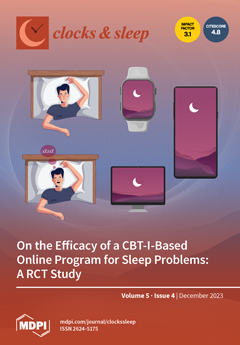There is an urgent need for easily accessible treatment options for sleep problems to reduce the current treatment gap in receiving cognitive behavioral therapy for insomnia (CBT-I). Using a randomized controlled trial, we evaluated the efficacy of a CBT-I-based online program on sleep.
[...] Read more.
There is an urgent need for easily accessible treatment options for sleep problems to reduce the current treatment gap in receiving cognitive behavioral therapy for insomnia (CBT-I). Using a randomized controlled trial, we evaluated the efficacy of a CBT-I-based online program on sleep. Fifty-three volunteers (21–71 years;
MAge = 44.6 ± 12.5; 27 female) suffering from impaired sleep were randomly allocated either to the experimental group (EG,
n = 27) or to an active control group (CG,
n = 26). The EG participated in a 6-week CBT-I-based online program, while the CG received psychoeducation and sleep hygiene instructions. Sleep was assessed both objectively via ambulatory polysomnography (PSG) as well as subjectively via questionnaires at three time points (baseline, pre- and post-intervention). A one-month follow-up assessment was performed using questionnaires. The EG showed small but reliable improvements from pre- to post-intervention in PSG-derived wake after sleep onset (from 58.6 min to 42.5 min;
p < 0.05) and sleep efficiency (from 86.0% to 89.2%;
p < 0.05). Furthermore, subjective sleep quality (assessed via Pittsburgh Sleep Quality Index) improved significantly during intervention (
p = 0.011) and follow-up (
p = 0.015) in the EG alone. The Insomnia Severity Index decreased from pre- to post-intervention in both groups (EG:
p = 0.003, CG:
p = 0.008), while it further improved during follow-up (
p = 0.035) in the EG alone. We show that a CBT-I-based online program can improve sleep not only subjectively but also objectively and can be a viable alternative when face-to-face interventions are not available.
Full article






